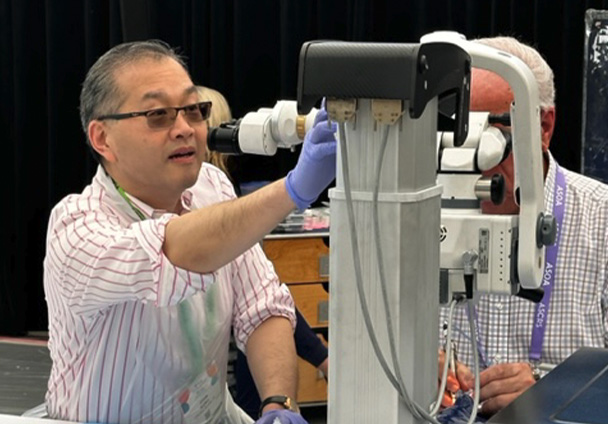Free LASIK Consultation: Call (855) 875-2020 9:00am–5:00pm

Fuchs’ dystrophy (pronounced fooks), also known as Fuchs’ corneal dystrophy or Fuchs’ endothelial corneal dystrophy, is a disease of the cornea that affects the endothelium layer, which is the innermost layer of the cornea. The corneal endothelium layer consists of a group of cells that help keep the cornea clear by pumping out excess fluid. When the healthy endothelial cells undergo degenerative changes, they can decrease in number and fluid can start to build up. Fuchs’ endothelial dystrophy causes corneal swelling and cloudiness and leads to blurry or poor vision.
Fuchs’ dystrophy usually affects both eyes and can cause blurriness due to the swelling of the cornea (corneal edema) and clouding. As the disease progresses, bullous keratopathy can occur, which causes tiny blisters called “epithelial bullae” to form.
Symptoms of Fuchs’ Dystrophy include:
Gain a deeper understanding about the topics, conditions, and procedures discussed on this page by watching our informational videos.
There are certain factors that may increase the risk of Fuchs’ dystrophy. These include:
If you are experiencing any of the above symptoms, or if they worsen with time, be sure to see an eye care professional who may then refer you to a corneal specialist. If you experience symptoms that occur suddenly, be sure to see your eye doctor as soon as possible, as there are some other eye conditions that cause similar symptoms as Fuchs’ dystrophy that may require prompt attention.
Although patients may be able to relieve some of their symptoms with eye drops or ointments, as Fuchs’ dystrophy progresses, many patients must undergo a partial corneal transplant surgery called DSAEK. This procedure can treat vision problems and corneal thickness to give you an improved quality of life.
In order to manage Fuchs’ dystrophy and improve vision, corneal surgeons today can perform a partial corneal transplant called Descemet Stripping Automated Endothelial Keratoplasty (DSAEK), which removes the damaged endothelium cells and replaces them with healthy donor tissue. The procedure has seen tremendous success and most patients that undergo DSAEK regain clear vision.
The DSAEK procedure offers many benefits over other corneal transplant options, including a much smaller incision and fewer sutures. Recovery time is also greatly reduced and patients meet their visual potential much quicker compared to traditional procedures.
If you are interested in learning more regarding Fuchs’ dystrophy and DSAEK, contact Kung Eye today! Our friendly and helpful team will be happy to assist you in scheduling your eye appointment with one of our skilled eye care professionals.
Please call our New York office at (929) 429-2928 or our New Jersey office at (732) 724-2535 with any questions you may have.
STATEN ISLAND, NY EAST BRUNSWICK, NJ
Dr. Kung’s mastery in ophthalmology means you will receive thoroughly informed recommendations for vision correction and maintenance, and that your treatment will be expertly performed for the best possible results.
MEET THE DOCTORS